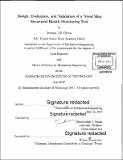Design, evaluation, and validation of a naval ship structural health monitoring tool
Author(s)
Olena, Jessica Jill
DownloadFull printable version (13.24Mb)
Other Contributors
Massachusetts Institute of Technology. Department of Mechanical Engineering.
Advisor
Themistoklis P. Sapsis.
Terms of use
Metadata
Show full item recordAbstract
The US Navy implements structural preventative maintenance procedures onboard its vessels using ship's personnel inspection. These procedures have been largely successful in identifying major problem areas before any interference with mission execution has occurred. However, changes in the Navy's manning philosophy to minimal manning and new ship designs focused on automation encourage a re-evaluation of these structural preventative maintenance procedures. Automation of structural inspection and damage detection would reduce associated manpower costs as well as inform better preventative maintenance schedules for US Navy vessels. This study outlines a modeling tool for structural health monitoring using nonlinear Kalman Filter methodologies such as the Extended Kalman Filter and the Ensemble Kalman Filter to identify damage within a structural model. Through the observation of structural responses and the formulation of a Kalman Filter, it is possible to produce estimates of structural parameters related to damage, specifically changes to elastic modulus and changes in material density. The results of this modeling tool were evaluated to quantify the time and length scales required for damage detection and were validated against a structural model generated in the MAESTRO Global Structural Analysis software suite.
Description
Thesis: Nav. E., Massachusetts Institute of Technology, Department of Mechanical Engineering, 2017. Thesis: S.M., Massachusetts Institute of Technology, Department of Mechanical Engineering, 2017. Cataloged from PDF version of thesis. Includes bibliographical references (pages 123-125).
Date issued
2017Department
Massachusetts Institute of Technology. Department of Mechanical EngineeringPublisher
Massachusetts Institute of Technology
Keywords
Mechanical Engineering.